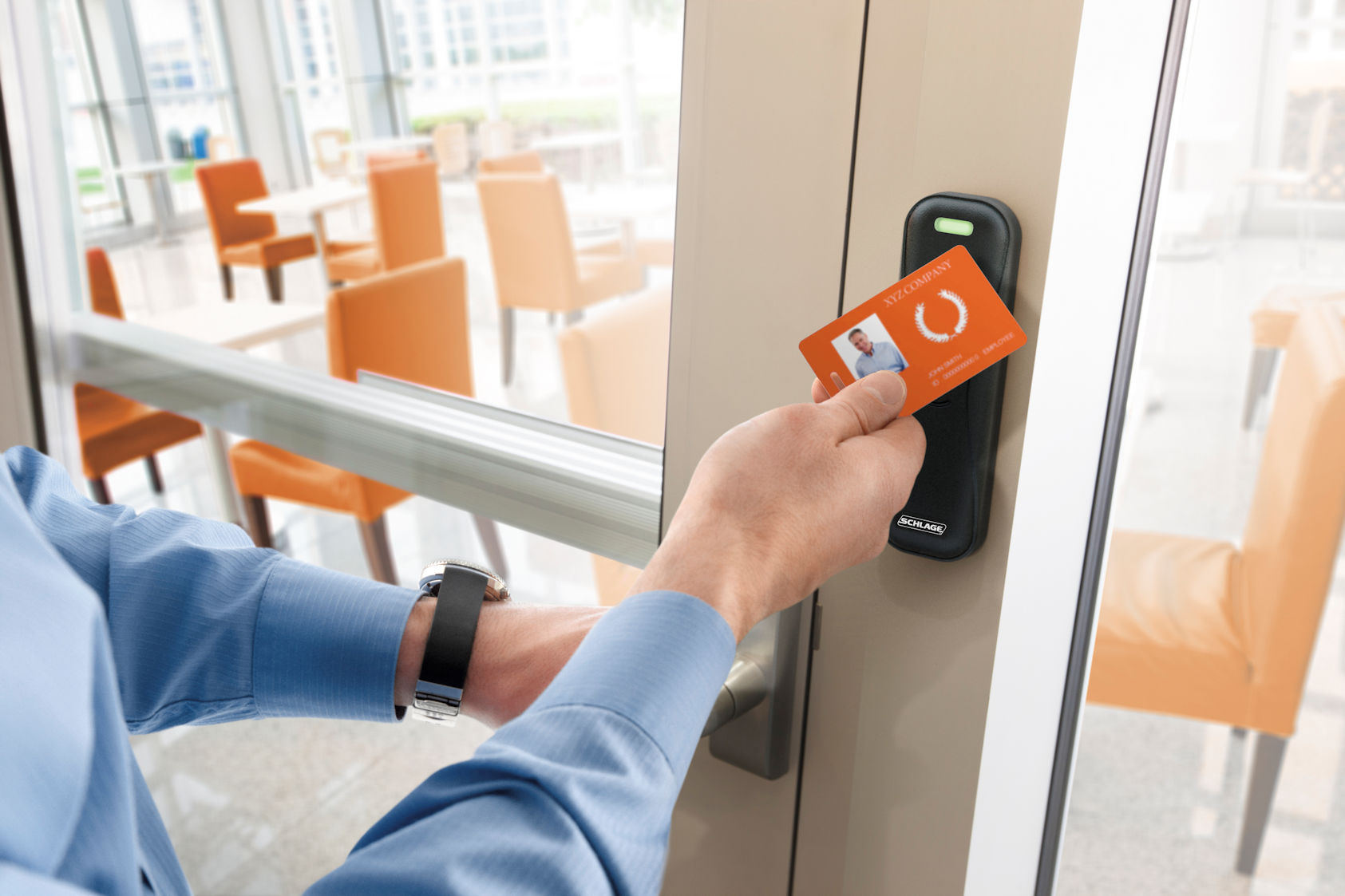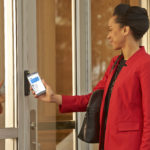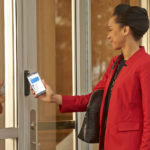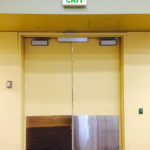My next Decoded column addresses important code clarifications related to electrified hardware used in access control systems. I hope this article will help with more consistent interpretations of the requirements.
This post was published in Door Security + Safety


The most common access control application is one where the reader limits access but the door hardware allows free egress. This is considered a normal locking arrangement.
In a previous Decoded article, the topic of normal locking arrangements was addressed. This electrified hardware is the most common type of access control application, where the hardware controls access/ingress, but does not affect egress. With these systems, the door hardware – such as a lever handle or panic hardware – is used to unlatch the door from the egress side, just as it would if the hardware was not electrified. Building occupants can exit through the door at all times, regardless of the status of the access control system.
Although this type of access control hardware operates to allow egress in the same way that mechanical hardware does, there has been confusion resulting in inconsistent interpretations of the model code requirements. Both the I-Codes and the NFPA codes include sections addressing special locking arrangements such as delayed egress, controlled egress in health care facilities, and electromagnetic locks released by a sensor or a switch in the door-mounted hardware. These sections do not apply to electrified hardware that allows egress via mechanical operation of the hardware.
Over the last few editions of the model codes, progress has been made to help clarify the intent of the code requirements related to electrified hardware. Many code changes have been implemented, with more to come in the 2024 editions of these codes, and the Commentary edition of the International Building Code (IBC) has been edited to include more explanatory information about access control doors. Unfortunately, the difficulties involving interpretations have continued.
I have been involved with many situations where code officials, architects, integrators, and security consultants attempted to apply the special locking arrangements sections of the adopted code to door openings equipped with normal locking arrangements. There is currently no section in the model codes that specifically applies to electrified hardware that is not one of the special locking arrangements. Therefore, the hardware used in normal locking arrangements must comply with the requirements that apply to mechanical door hardware.
For example, consider a very simple access control system where the reader on the outside of the opening controls an electric strike. The electric strike releases the latch for access when the proper electronic credential is presented to the reader. On the egress side, turning a lever handle or pushing the touchpad of a panic device retracts the latch to allow a building occupant to exit; the operation would be the same if the door had mechanical hardware without an electric strike.
Other examples of this type of system – a normal locking arrangement – would be:
- electromechanical lock where the access control system controls access via the outside lever and the inside lever allows free egress at all times
- electrified lever trim for panic hardware or fire exit hardware, where the access control system controls access via the outside lever and the touchpad or crossbar on the panic hardware allows free egress at all times
- electric latch retraction panic hardware or fire exit hardware, where the access control system electrically retracts the latchbolt for access, and the touchpad or crossbar on the panic hardware allows free egress at all times
If the code sections addressing special locking arrangements are applied to a door with a normal locking arrangement, it can result in modifications that are unnecessary and sometimes even detrimental to the operation of the assembly. I have seen normal locking arrangements with an auxiliary push button marked “push to exit” beside the door. This is required for an electrified lock that is released by a sensor but serves no purpose for a door with hardware that allows free egress via the lever handle or panic hardware. I have also seen normal locking arrangements where the code official required the electrified hardware to be unlocked upon fire alarm or power failure. This is required by code for some types of special locking arrangements but not for normal locking arrangements. When the hardware allows free egress at all times, unlocking the electrified hardware during a fire alarm or power failure negatively impacts security while doing nothing to improve egress or life safety.
2021 IBC Commentary
Helping code officials, architects, and others to apply the correct code sections to each type of electrified hardware application has been a challenge, but the 2021 IBC Commentary helps to clarify the intent of the code. Regarding Section 1010.2, Door Operations, the Commentary states that doors in a means of egress can be locked on the outside/access side, requiring a key or electronic credential for ingress, as long as the egress side can be unlocked without the use of a key, tool, special knowledge or effort.
The 2021 IBC Commentary also addresses a common question:
“If a door has an access control system (such as a card reader and electrical locking hardware affecting ingress into a space) what does the code require for an access control system on the ingress side of the door?”
As stated above, the answer to this question in the Commentary clarifies that some egress doors with electrified hardware are considered special locking arrangements and must comply with one of the applicable sections of the code. However, according to the 2021 IBC Commentary, the most common application for electrified hardware includes an access control reader on the ingress side to control access, with door hardware on the egress side that allows free egress at all times. The explanatory language in the Commentary states:

This electrified lockset incorporates a credential reader on the access side, but the inside lever always allows free egress. This is not a special locking arrangement.
“A door with this most common configuration of electrified hardware is subject to the same requirements as a door with a mechanical lock controlling ingress (such as a lock operated by a key on the outside): the door must allow free and immediate egress with one releasing motion to unlatch the door, without the use of a key, special knowledge or effort, and with no tight grasping, tight pinching, or twisting of the wrist.”
In addition, the accessibility requirements limit the amount of operable force that may be used to release the latch, and the standards require releasing hardware to be mounted between 34-48 inches above the floor (with some exceptions).
The clarifications in the 2021 IBC Commentary will help with interpretations related to electrified hardware, and the intent will be further clarified in the 2024 I-Codes. A change has been approved for the 2024 IBC which will require doors with access control to have hardware that complies with one of the sections addressing special locking arrangements, OR hardware that “shall be readily openable from the egress side without the use of a key or special knowledge or effort.”
UL 294 – Standard for Safety Access Control System Units
One of the problems created by interpreting every door with electronic access control as a special locking arrangement is related to UL 294 – Standard for Safety Access Control System Units. The model codes do not require every item of electrified hardware to be listed to the UL 294 standard – it is only required by some of the sections addressing special locking arrangements. There are some items of electrified hardware that are not typically listed to UL 294 because they are not used in the types of systems where this listing is required by code. These products often carry other UL listings, like UL 1034 – Standard for Safety for Burglary-Resistant Electric Locking Mechanisms
In the 2021 IBC, the UL 294 listing is required for systems incorporating delayed egress locks, controlled egress locks in health care facilities, and locks released by a sensor or a switch in the door-mounted hardware (typically electromagnetic locks). If a system that incorporates electrified hardware is not considered one of these types of systems, the IBC does not require the UL 294 listing. The 2021 IBC Commentary clarifies the intent of the code, stating:
UL 294, Standard for Access Control System Units, applies to construction, performance and operation of systems that control passage through a door and the electrical, electronic or mechanical units of these systems. Item 6 requires the locking system units of the door hardware release electrical locking system to comply with and be listed in accordance with UL 294. It may be appropriate to recognize that this code does not require the units of an access control system (ingress control system) to be listed to UL 294.
A change to the 2024 edition of the IBC has been approved (ICC proposal E52-21) and will allow electrified hardware to be listed to either UL 294 or UL 1034. Similar to the 2021 edition of the code, these listings will be required only for certain types of special locking arrangements and not for all electrified hardware.
Conclusion
Electrified hardware can be very confusing, especially when applying the code requirements to the various types of access control systems. In summary, here are a few things to keep in mind:
- Special locking arrangements are those where egress may be affected by the access control system, and the model codes include sections that apply to each of these applications.
- Access control systems that limit access but do not affect egress are typically considered normal locking arrangements and must comply with the requirements for mechanical door hardware.
- Refer to the adopted code for specific requirements that apply to special locking arrangements. The I-Codes and the NFPA codes vary slightly, and there may be state or local modifications to be aware of.
- The 2021 IBC Commentary and changes approved for the 2024 edition of the IBC will help to clarify the intent of the code on the requirements for special locking arrangements vs. normal locking arrangements.
For more information, refer to the adopted codes in the project’s jurisdiction, and consult the Authority Having Jurisdiction (AHJ) if assistance is needed. The 2021 IBC Commentary, which includes explanatory information clarifying the intent of the IBC, can be purchased from the website of the International Code Council: ICCsafe.org.
You need to login or register to bookmark/favorite this content.









Great article and very informative!
Thanks Charles!
– Lori
So many people need to know this stuff, but it is so hard to find! Let alone with interpretation! Thank You!
One thing I’m still confused about: In a maglock setup with a panic bar with nothing special/not delayed etc (R-4 apartment bldg exit), if I have a keypad, does the Keypad have to be UL 294 still? I mean, it’s only used for entry, not exit. But it’s all wired on the same system, so ??
Thanks!
Hi Max –
Past codes were not clear on this, so it was left up to AHJ interpretation. For example, the 2021 IBC says: “The locking system units shall be listed in accordance with UL 294.” Is a keypad a locking system unit? Who knows?
This has been clarified in the 2024 IBC, which says: “The electromechanical or electromagnetic locking device shall be listed in accordance with either UL 294 or UL1034.” This is saying that the locks themselves need the listing, not the other components of the system. Based on this change/clarification, I would say that the intent of the code is/was for the listing to apply to the lock and not to the keypad, but an AHJ could have a different interpretation of the previous language.
When a particular jurisdiction adopts the 2024 IBC, it will be clear. Until then, not so much.
– Lori